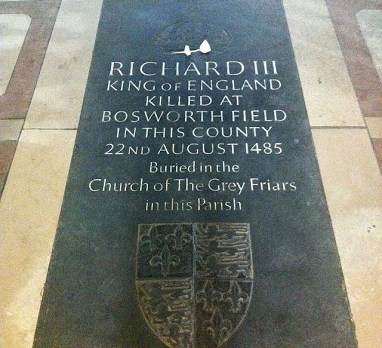New research, published in The Lancet medical journal, indicates that Richard III, last of England’s Plantagenet kings and long immortalized as one of Shakespeare’s greatest villains, died in battle after losing his helmet.
The death of Richard III at the Battle of Bosworth in 1485 ended the War of the Roses and allowed Henry Tudor to accede to the throne as Henry VII, founding a dynasty that would break with the Catholic Church and establish the Church of England. King Richard’s remains were found in September 2012, under a car park built on the site of what had been Leicester’s Franciscan Priory until it was demolished after being dissolved by Henry VIII in 1538.
According to "Perimortem trauma in King Richard III: a skeletal analysis," detailed whole-body computed tomography (CT) scans and micro-CT imaging reveal that he suffered 11 wounds at or near the time of his death, all except two to his skull.
Leicester University’s Professor Sarah Hainsworth said the wounds point to the king having undergone a sustained attack or one from several assailants. The nine wounds to his head, sharply contrasting with “the absence of defensive wounds on his arms and hands,” suggest that when he was struck down he lacked a helmet but was otherwise still wearing his armour.
Co-author Guy Rutty said that the injuries most likely to have killed the king were two to the base of the skull, one that may have come from the edge of a sword or bladed staff weapon such as a bill or halberd, and one from a pointed weapon that was driven 10.5 cm into the monarch’s head.
These injuries, Rutty said, “are consistent with some near-contemporary accounts of the battle, which suggest that Richard abandoned his horse after it became stuck in a mire and was killed while fighting his enemies.”
Earlier this year, following a dispute with the Plantagenet Alliance that had wanted Richard buried in his home city of York, the High Court confirmed that the king’s remains would be reintered in Leicester Cathedral. Tim Stevens, Anglican bishop of Leicester, has confirmed that Justin Welby, Anglican Archbishop of Canterbury, and Cardinal Vincent Nichols, Archbishop of Westminster, would attend the service on March 26 , 2015; it is expected that Archbishop Welby will lead the ceremony.
Although the service will resemble a state funeral, it will not be classed as one, not least because, as Father Andrew Cole, communications officer for the Diocese of Nottingham (which includes Leicester) has pointed out, “His funeral has already happened. A Christian ceremony was held and his body was given back to God.”
Commenting on the upcoming ceremony, Cardinal Nichols described Richard III’s death as a decisive moment in English history, and said that it was “fitting that his remains should be reintered with dignity and accompanied by the prayers of the Church in Leicester Cathedral, the medieval parish church of Leicester.”
Greg Daly covers the U.K. and Ireland for Aleteia.

